

Travel Baseball Uncovered: A Guide For Parents And Players
Let’s talk about baseball—travel baseball, to be exact.
For many, moving from the Little League to travel baseball feels like catching a curveball. After all, it’s more than just a pace change; it’s about trading Saturday afternoon matches on a grassy field for serious club competitions that come with a higher price tag.
You might be thinking, “Is this the right play for my little slugger?” or “How do I even go about choosing a team?”
Well, here’s our chance at bat. We’ll walk you through everything youth travel baseball has to offer, including answering these questions and more.
Table of Contents
What is Travel Baseball [Explained]
Travel baseball is just what it sounds like. It’s when youth teams have to travel in order to have their games and tournaments. This is usually the next step after traditional recreational or Little League.
Since the level of competition is much higher, it can help them develop their skills.
But preparation comes at a cost—literally. And all that time on the road can take up your schedule very quickly. But despite all that extra work, they’ll get an exciting adventure out of it. Now, they’ll face off against teams from different cities, states, and sometimes even countries.
The love for Travel Baseball is Growing Fast.
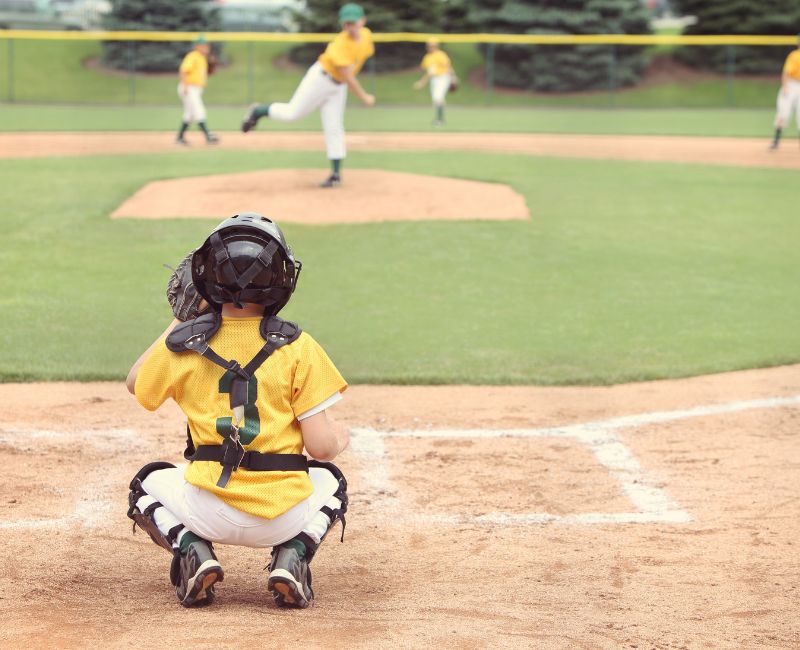
In recent years, travel baseball gained an exponential amount of popularity and saw thousands of teams pop up across the country.
Before the 90s, it was a relatively niche experience only limited to players nestled in regions like Texas and California.
Nowadays, participation is considered necessary for young players wanting to sharpen their skills and go up against some really tough competition.
Instead of focusing on the local leagues like recreational youth baseball does, travel ball operates under various organizations, hosting hundreds of tournaments each year.
Some big names include USSSA (United States Specialty Sports Association), AAU (Amateur Athletic Union), Triple Crown Sports , and Perfect Game .
The ambitious goal for any team is to face off against as many different teams as possible to gain experience and test their skills.
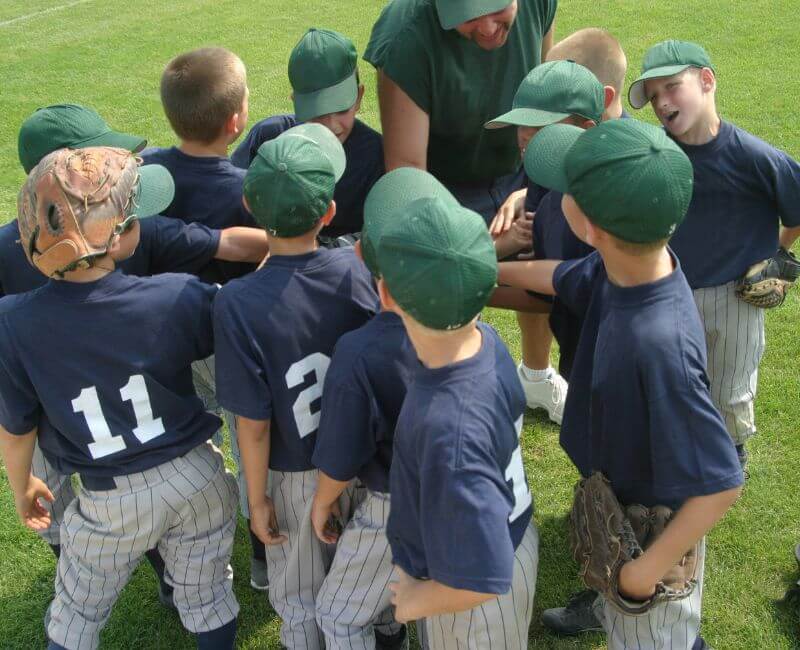
Everyone can create a travel baseball team. It doesn’t matter if you’re a parent, high school teacher, or someone who coaches college kids.
The highlight of the season is the travel baseball tournament. Bringing together talented teams from different parts of the world to compete.
This lets players show their skills to a bigger audience, including scouts and college coaches. These tournaments are organized by many institutions and happen locally, regionally, or even nationally.
There’s nothing cooler than the USSSA World Series, though. Every year, it’s hosted by the United States Specialty Sports Association.
You’ll find talent from all over America coming here to fight for that top spot. But another epic tournament is the Triple Crown Summer Nationals, where they hold it at Myrtle Beach
in South Carolina. It attracts teams from everywhere and is known for great competition and vacation vibes.
A unique little competition is held in Cooperstown, New York, known as the Cooperstown Dreams Park Tournament.
Cooperstown, known as baseball’s birthplace, offers a unique week-long stay in baseball-style barracks. You can visit the National Baseball Hall of Fame.
These intense and challenging tournaments bring out some of the most talented players young kids have to offer. It’s also a great way to boost your young player’s confidence in playing on those big stages!
Different Levels Of Travel Teams And Their Requirements
It’s not just one level fit all for travel baseball teams. They’re organized into various levels based on skill, experience, and commitment from players.
Imagine putting someone who only knows how to throw with moderate force into a contest against someone who does it with full force.
The team you choose for yourself should align with your skill level, how much free time you have, and your developmental needs as a player. Here’s an overview of different levels:
1. Local Travel Teams : For beginners starting their journey through travel baseball. The games they play are mostly local or within a close driving distance. Practices only happen a few times a week, and games during the weekend.
2. Regional Travel Teams : For players with more experience and higher skill levels. They go on trips for games and tournaments that will require overnight stays at places. Commitment level is higher, with practices being more frequent along with a longer season.
3. Showcase Travel Teams : The big leagues of young kid baseball players. These teams are made up of highly skilled people who are very serious about baseball. They have college scouts and recruiters present their games. This includes going to different states for showcase tournaments.
You’ll need to be extremely committed to even think about trying out for this team, and their practices are rigorous and frequent, lasting all year round!
Benefits of Playing in a Travel Baseball Team
A lot of benefits come from playing travel baseball.
The biggest one? It can help players get to their goals. It’s not just about playing a game, especially when you want to make it big. It’s actually an experience that provides lifelong skills that can be applied everywhere else.
Competition in recreational leagues is nothing compared to this. It’s way higher. This allows players to grow new and old skills at a faster rate.
There’s also an intense training schedule that demands discipline, resilience, and focus. These qualities go beyond just sports.
Participating in high-profile tournaments also gets the attention of other coaches and scouts. Which makes it easier for them to open doors for scholarships and professional contracts.
Traveling away from home just for games might seem like a drag, but it builds responsibility and maturity. It is a demanding journey for sure, but very rewarding.
Did MLB Players Play Travel Baseball?
Definitely! A lot of Major League Baseball (MLB) players used travel baseball as their starting point, too. It gives them all the exposure they need, honing skills at such a young age along with fierce competition.
Take Bryce Harper , for example. He’s one of the biggest names in MLB today. His journey started back when he was a child playing for the Southern Nevada Bulldogs 14U travel team. The opportunity came up where he could go against older players who were more experienced than him. This experience helped shape his professional career.
Albert Pujols also played travel baseball when he was younger on his team called Fort Osage Indians Travel Team before sailing into the Hall of Fame.
Clayton Kershaw ? Yeah, him too! Another name you hear often in MLB didn’t start there either — he played for the Dallas Tigers Travel Team where he developed early on gaining crucial skills and discipline that are instrumental in his success today.
How to Find a Travel Baseball Team in Your Region?
If you’re a young baseball player who wants to take their skills to the next level, then joining a travel team is a great opportunity. If you are a parent and want to make your child the next MLB star, then travel baseball teams are a great place to start with.
These teams play across the country and allow players to show their talents against top-tier competition. But how do you find one of these teams?
Here’s a guide on how you can join a travel baseball team in the USA.
Check your local youth baseball organization.
Your first step should be checking with your local youth baseball organization. Chances are they have travel teams that play in leagues and tournaments outside of the regular season. If they don’t, then it’s likely they know someone who does.
Drop by showcases and camps.
In-person events like showcases and camps are great places to meet coaches and scouts from travel baseball teams. They’re designed specifically so players can showcase their skills and get noticed by recruiters.
The internet holds many answers, including finding a travel baseball team. Websites like USSSA Baseball, Perfect Game USA, and Travel Ball Select list lots of travel baseball teams based on state, age group, and skill level — all at a click away.
Talk to other parents and players.
If you want first-hand experience, then talk to other parents or players who have been through this process before. They can give useful insight into which teams are reputable, well-run, and competitive.
For example, if you live in Texas, then one option could be the Texas Bombers Baseball Club — an organization that has multiple teams at different age levels and is known for developing young talent. You can learn more about them by visiting their website or attending one of their tryouts.
How to Find the Perfect Travel Baseball Team?
Identify the skill level and commitment of the player.
First thing first, you need to figure out how committed your child is to the sport and their skill level. If he is naturally gifted athlete then you should help him to follow his dream.
Research Local and Regional Teams
Begin by looking at teams that are close by. These teams usually have varying levels of skill and serve as great entry points for most players.
You can check their websites and social media pages to learn more about them such as philosophy, coaches, players, and game schedule.
Attend Local Games and Practices
Sitting in on local games and practices allows you to get a firsthand look at how they run things. You’ll be able to see their coaching style, how they interact with the players, and the overall team dynamic. With this insight, it’ll be easier to make a decision.
Speak with Coaches and Parents
While observing is good, it isn’t enough. Take some time out of your day or week to speak with coaches.
This allows you to gain an understanding of their training methods, the expectations they have for your child, and the goals they want them to reach. It’s also good practice to talk to other parents so you can get a general idea of what people think about the team.
Consider Logistics
Logistical factors are important, too, so don’t forget about them. Make sure that the team’s practice location is suitable for you and your family’s schedule since it may be far away from where you currently live or work.
The game schedule should be looked at as well because there could be conflicts in dates that would keep you from attending games.
Tryouts & Evaluations
Most teams hold tryouts or evaluations for people who are interested in joining. If this is offered, take advantage of it because it gives your child the chance to showcase their skills and for you to see if the team would be a good fit.
A player’s evaluation is also helpful because it gives you insight into how strong the team itself is.
Travel Baseball Season Preparations
Preparations before the pre-season.
Before the baseball season starts, you’ll want to make sure that your child is mentally and physically ready for the long days ahead.
So, let’s start with an off-season workout routine to help build strength and agility. But don’t forget about eating well and getting enough sleep. Plus, practicing regularly can take their fielding, pitching, and hitting skills way up.
During the season
Once the season starts, it’s important to stay fit and perform at your best. You’ll want to communicate with their coach to keep track of your child’s progress as well as any areas they need improvement in.
Another thing you should do is show up to their games and practices. It helps you stay in tune with how the team is performing and also supports your child. And finally, always keep their lines of communication open, whether it’s about pressure or their anxiety.
Post-Season
After a long season, it’s important to take a break. Reflect on the games you had together. Acknowledge all the good things they did but also focus on areas they can improve in.
Give them some downtime so they can rest and recover. Even though they’re chilling around, don’t let them become bums — physical activity is still important for them during this time.
Travel Baseball vs. Little League
Both types of baseball have their own unique experience and benefits that come along with it. The choice of which one to put your kid into mostly depends on what they want out of it.
For example, travel baseball is more competitive. It attracts players who are committed to sports no matter what and are willing to travel around just for a game against top talent in various regions. Not only does this provide intense competition but also high-level coaching.

It does require a lot of time, as seasons are much longer than in little leagues with more games and practices.
If you want your child exposed more, then this would be a good option, as you can see from Bryce Harper, Albert Pujols, and Clayton Kershaw.
Now, little league baseball is less demanding. It’s generally more focused on the community and not so much on traveling and time.
It’s actually a great option for kids who still love the sport but aren’t ready to commit to such a demanding schedule. They focus on learning fundamental skills, enjoying the game, and fostering a sense of community.
You can learn more here: Travel Baseball Vs Little League
The Cost of Playing Travel Baseball
If your kid has a future in baseball, you might want to consider enrolling them in travel baseball. The only problem is that this option is much more expensive than local leagues.
Local leagues tend to have low costs because they don’t do as much traveling as travel teams have to do. On top of paying for the actual games themselves, there’s also the top-of-the-line coaching and amazing facilities that the team needs to cover.
You’ll be hit with fees like equipment, uniform, tournament, travel (like gas and airfare), and a team fee.
The team fee alone can include things like league fees, practice facility rentals, and salaries for the coaches.
And let’s not forget about any extra training or lessons they need in order to take their skills up a notch.
It’s always good to ask the people organizing the league what you’re paying for specifically because then maybe it won’t seem so bad (it probably will still seem bad, though).
But it really does come down to where you live.
Depending on that, it could cost you anywhere from $1,500-$3,000 per season. And if you’re on one of those elite teams competing at national tournaments, then I’m sorry, but it’ll probably cost way more.
Find Out How To Choose A Coach
A good coach doesn’t just teach how to play sports but also builds discipline and confidence, along with fostering a love for the game. Here are some tips on picking a coach:
Experience And Certification : A coach should always have some kind of experience coaching youth sports, but having proof that they passed some coaching program can give you peace of mind, knowing they know what they’re doing.
Coaching Style : Every coach is different and will treat their athletes differently, too. Some will be very intense in trying to push their players, while others are more relaxed yet inspiring. Pick what works best with your child’s personality.
Communication Skills : A good coach knows how to explain things in a way that’s easy for their athletes to understand. They should also be great at talking to you and other parents.
Focus On Development : It’s better for your kid to improve their skills rather than just win all the time. Look for coaches that will work with them on that.
Reputation : Finally, look into what other people say about the coach. Not only other players but parents, too. It doesn’t hurt to ask around or even watch them during practice if you can.
Things to Know About Uniforms and Equipment in Travel Baseball
Uniforms and equipment are a necessary investment in travel baseball. It can be beyond what you expect from Little League. Here’s a quick rundown of what your child might need:
Uniforms : Most travel baseball teams have their own custom jerseys that come with pants, caps, belts, and socks. Some teams may even have home and away uniforms, so check with the manager first.
Gloves/Mitts : Get your child a good quality glove or mitt that suits the position they play. For example, catchers and first basemen have their own special mitts, while outfielders use bigger gloves compared to infielders. Check out the Best Youth Infield Gloves
Bats : Bat rules can get very specific, depending on the league. Before you buy one, make sure you understand what kind is allowed. Also, consider their height, weight, and hitting strength when selecting the right bat size .
You can check out my list of Best Youth Baseball Bats
Helmets : No matter how old or young your child is, they need a batting helmet. Some leagues even require faceguards as well. Check out the Best Youth Baseball Helmet
Cleats : Running on grass and dirt requires traction, which is why cleats are used in baseball. However, be aware that some leagues don’t allow metal spikes, so again, you should always check if there are any shoe restrictions.
Protective gear : Depending on the position they’re playing at, your kid may need extra protection such as shin guards for their legs or a chest protector for their torso
What is a good age range for travel baseball?
Travel baseball typically starts around 7 or 8 years old and goes through high school. However, the age that you can join may differ depending on the league or team.
How much does it cost to play travel baseball?
The price of playing travel baseball could be greatly different depending on things like where you live, what team you’re on, and at what level you play. You’ll have to pay for league fees, uniforms, equipment, and even the costs of traveling and staying in other cities for away games.
How often would we need to practice?
Usually, travel teams practice more often than recreational ones. It’s common for them to meet several times each week. But it will depend on the time and dedication your child’s coach expects.
How far do they have to go?
Again, that’ll depend on what league your child signs up for. Some teams only need to go a couple of miles, while others will have to cross city lines.
Can my child also play another sport?
It all depends on how much time both sports require. Understandably, travel baseball takes up quite a bit of time and energy, so consider if they have enough for both.
Overall Worth of Travel Baseball
Traveling with a baseball team is no joke. For players and families alike, it’s considered a big commitment that takes up lots of time, money, and energy.
And while it opens up new opportunities, the best reward for joining one is amazing! The skills learned, and knowledge gained from playing at higher levels is priceless.
Plus, it builds character, helping to teach important lessons like teamwork, dedication, success handling, and, most importantly, failure handling. And let’s not forget about the friendships built along the way from spending hours with teammates in different places across the country.
Even though some costs and sacrifices come with this commitment, most families say joining a traveling baseball team was totally worth every bit of it.
Just remember, the end goal is to love the sport and grow as a person.

Hello everyone. My name is Jason Butler, and I live in California, America. I was a professional AAA Minor League Baseball player. I lost my chance of playing MLB for injury issues, but I did not lose my love for baseball. I attended the coaching training program and am now working as a coach in a small school in San Diego.
I always love to share my experience and knowledge if that can help you. Play baseball, and stay fit.

Travel Baseball: The Ultimate Guide for Parents and Players
Table of Contents
What is travel baseball, what to look for in a travel baseball team, travel baseball vs. little league, travel baseball pros and cons , criticisms and controversy, is travel baseball worth it.
For many families, the transition from Little League to travel baseball comes with stress, anxiety and questions about what to look for in a team and what to expect from the experience — not to mention the question of whether making the switch from a more laid-back rec ball program to a more competitive (and expensive) travel club is the right decision in the first place.
In this post, we’re going to go over everything you need to know about getting started with youth travel baseball. We’ll help you answer the questions above and determine whether travel baseball is a good fit for your son or daughter.
If you have a softball player in the family, you may also want to check out our article “ What to Look For in a Travel Softball Team ,” which covers some of the same information from a softball perspective and dives deep into my personal experience as an elite-level amateur player and college recruiting prospect.
Table of Contents :
- How to Choose a Travel Baseball Team
- Travel Baseball Pros and Cons
- Is Travel Baseball Worth It?
First, it’s important to understand what a travel baseball team is and how travel baseball is organized.
There are tens of thousands of travel baseball teams around the country, and their popularity has exploded over the past two decades. As recently as the 1990s, travel baseball was a niche experience limited mostly to elite players in baseball-rich areas like Texas and California. Today, participation is seen by many as a near necessity for talented players to develop their skills and hone their game against the best competition they can find.
Whereas Little League is the dominant organization when it comes to recreational youth baseball, there are multiple organizations throughout the country that host hundreds of travel tournaments each year. Some of the biggest and most popular are USSSA (United States Speciality Sports Association), AAU (Amateur Athletic Union), Triple Crown Sports , and Perfect Game . Travel baseball teams often participate in tournaments organized by more than one of those organizations.
A team can be started by anyone. Many are formed by parents, but many others are formed by high school and former college coaches. Depending on their organizational goals, some programs have just one team that participates in one age bracket (such as 10 and under), while some are run like businesses and have teams that compete in every age group.
Some huge organizations, such as California Baseball Academy (CBA), even have multiple teams within the same age group, located in multiple cities. CBA has teams not only in California, but also in Nevada, Texas, Utah and the southeast. High-level programs like that are often known for attracting top talent, for training recruits into elite players, and for feeding those players into nearby colleges and universities.

Travel Baseball Competition Structure
Virtually all travel baseball games are played on weekends in a tournament format. Those tournaments can theoretically be held anywhere, but are frequently held at multi-field facilities in easily-accessible travel hubs. For example, many Florida tournaments are held in Orlando because it’s in the relative center of the state, it has plenty of hotel rooms, and it’s home to many great baseball facilities. The farther you live away from such a hub, the more you should expect to travel.
Most tournaments begin with pool play, meaning that teams are guaranteed a number of games before heading into single elimination. A team can expect to play anywhere from three to eight games over the course of a two-day or three-day tournament, depending on how they perform.
There is no set number of tournaments a team must participate in. Each team decides which tournaments to enter on a case-by-case basis, taking into consideration factors such as age level, skill level, and cost. In general, two tournaments per month can be seen as about average, although higher-level teams may play more frequently.
Most organizations run regional and national championships, which are invite-only. For example, USSSA hosts “qualifier” tournaments, where the winner of the championship game (and sometimes the runner up) can earn a bid to the USSSA national tournament.
Additionally, beginning at age 14, some teams start participating in “college exposure tournaments,” where college scouts come from across the country to watch and evaluate prospects. These tournaments are typically more expensive than regular tournaments, and are often farther away.
How to Join a Travel Baseball Team
If you’ve decided to join a travel baseball team and aren’t sure where to find one, there are a number of resources available.
It may go without saying, but word-of-mouth can be a valuable first reference point. If you’re thinking about switching to travel baseball, chances are that you already know someone in your area who has made the jump. If so, don’t be afraid to ask them questions about the team and their experience. It’s a big commitment — both in terms of time and finances — so it’s important to make sure you find the right club for your son or daughter.
In addition to word of mouth, many organizations offer a list of active teams on their website. For example, USSSA has a tool that lets you filter teams by age level, skill level, and location . There are also many state-based forums and Facebook groups where coaches post their team’s tryouts (and positions needed). As an example, here are Facebook groups for travel baseball teams in Florida and Michigan — you can find similar groups for every state.
Another good option is FieldLevel.com , which (like the USSSA site) allows you to filter teams by state and level. While not every team is listed on that website, it does include over 4,000 clubs.
Here are eight things to think about when evaluating teams. These factors will make a big difference when it comes to your overall experience, so take the time to think about them, and don’t be afraid to ask questions of parents and coaches.
1. Coaching
A coaching staff can make or break a team. How coaches manage players, keep the game fun, instill the fundamentals, and focus on development — not only as athletes, but as young men and women — is extremely important.
Some travel baseball teams have parents or grandparents serving as the head coach. While that can be fine, it’s important to make sure those coaches don’t make keeping their own child on the field a priority. Before committing to a team, spend some time researching it by watching a practice and talking to current and/or former players and parents.
What’s the coaching style? Do they have high expectations but still encourage and love their players? Or, on the other hand, are they screaming at players when they make a mistake?
Additionally, are players treated equitably, or do some get preferential treatment based on their relationship to the coach or their financial contribution to the team?
Ideally, your child will be a part of that team and organization for consecutive years, rather than bouncing from team to team. As such, determining whether the coaching staff is a good fit is a crucial first step.
2. Cost
For many parents, this is the most terrifying aspect of travel baseball.
Just how much of a toll is this going to take on your bank account? The specific answer varies, but the typical range of cost for participating in travel baseball is between $500 and $2,500 per year.
That said, you can end up spending a lot more than that. Back in 2011, CBS News reported that one Georgia family paid $4,000 per year for their 9-year-old son’s travel team. You can imagine that older players in elite programs that travel all over the country can spend even more over the course of a season.
Typically, the more intensely focused a program is on developing its players for college baseball, the more money the program is going to cost. On the other hand, teams that are playing more for the fun of it — those looking for just a little more structure and competition than offered by Little League — won’t put as much of a dent in your wallet.
There are a number of specific factors that go into how much it costs to be on a team:
- Where you live . If you live in a baseball hub, like Texas or California, you won’t have to travel as far to get to tournaments. Many teams from rural areas regularly drive across multiple states (or sometimes even fly) to tournaments. As such, where you live will likely be the single biggest variable in your overall travel baseball cost.
- Whether you have to buy your own equipment . Some teams are sponsored by equipment companies like Easton and Rawlings and have their bats, gloves and cleats provided either for free or at a reduced cost. Obviously, this can be a huge savings. Also, keep in mind that (unfortunately) equipment is often viewed as a status symbol in travel baseball. If your child joins a team where every other player has multiple bats and position-specific gloves, he or she is going to press you for similar gear.
- Whether you have to rent facilities . Some teams practice exclusively at public fields. Others have little or no access to such facilities and have to rent fields and/or indoor space (especially for winter workouts). This can have a huge impact on the overall cost of participation.
- Whether or not coaches are paid . Some teams — typically the more competitive ones — pay their coaches small stipends and/or cover their cost of travel. On one hand, this tends to lead to better coaching. On the other hand, families are the ones who will ultimately foot that bill.
- How competitive the team is . Higher-level tournaments typically have higher fees. Lower-level tournaments, operated on a more sub-regional basis, are usually much less expensive to enter. If cost is a concern, make sure you know what types of tournaments the team usually enters over the course of the season.
3. Location
As stated earlier, location is a key factor in deciding which travel team to play for. If you’re fortunate enough to live in California, Florida or Texas, you’re going to have a lot of opportunities to play with and against high-level competition right in your backyard.
But outside of those states, it’s a little bit tougher, and you have to decide how committed you are to playing at the highest possible level.
For example, if you live in a medium-sized town outside of a major baseball hub, chances are you have at least a couple of travel ball options. However, the odds are that those options are not the absolute cream of the crop when it comes to coaching and competitiveness. In order to play for the absolute “best” team possible, you might have to commute from your mid-sized town to the nearest major city.
So you’ll be faced with the following choice: play on a lower level team that’s closer to home, or drive a hundred miles or more for twice-weekly practices? It may sound crazy, but many families do just that.
Why would they commit so much time and money to their son or daughter’s athletic pursuits? It comes down to goals. Better teams often provide better coaching and more opportunities for exposure to college and professional scouts.
What’s the team’s mission? Is the focus on fun, player development, college exposure, or a mix of all there? Teams can have many different goals and missions, and there’s no right or wrong approach.
However, it is possible that a team’s mission does not align with your values and goals, and you need to think about this before committing, as a compatibility mismatch can lead to coach-parent and coach-player tension.
5. Organization
Consider the reputation of the organization you’re evaluating. When you join a team, you and your son or daughter will essentially be endorsing everything the program stands for. If they’re known for dirty play or being disrespectful to the game, you’ll be associated with that.
And believe it or not, the baseball world is a small and surprisingly tight-knit community. College coaches tend to know which programs produce bad apples — and they avoid them. In fact, many college coaches will completely write off an entire organization that has a reputation for not playing the game the right way or for having disrespectful players.
6. Playing Time
There’s an important balance between getting enough playing time and being challenged. Before committing, ask the coaching staff what kind of playing time your child can expect — including at what position.
If there are two returning shortstops, he or she most likely won’t be playing there and might have to learn another position. That’s not a bad thing: college coaches want players that are versatile, and many players change positions as they get older and their bodies develop.
Still, it’s helpful to know what to expect ahead of time. Getting game reps is important from a development perspective, but also just from a fun perspective: no kid wants to consistently travel to a tournament only to sit on the bench for most of the weekend.
7. Skill Level
Be realistic about your child’s skill level, and pay attention to the level of competition around him or her at tryouts (i.e., the skill levels of the other players). If your kid has the fight and desire to compete for a spot (like they’ll have to do if they make it to college ball), then putting them on a team where they’ll be challenged is the best option.
But if he or she is there to have fun and make friends, with no burning desire to be constantly improving, then choosing a travel team that’s more low-key will be the better call.
8. What You’re Giving Up
Travel baseball tournaments are on weekends, and players often have to sacrifice certain things that are part of a normal childhood.
Is your son or daughter willing to miss out on things like birthdays, sleepovers and school dances, because most of their time is spent doing homework, traveling to and from games and practices, practicing on their own (possibly including private lessons), and spending nearly every summer weekend at the ballpark?
And are they willing to sacrifice the material things that matter to kids — things like clothes, video games, new smartphones, etc. — because so much money is being spent on baseball?
As I wrote in THV’s guide to travel softball , my family made major sacrifices to support my athletic pursuits.
For some, their love of the game is so great that giving up these things is a no-brainer. For others, they may regret missing out on these social activities. And that’s perfectly fine! Just be honest with each other and talk about the true costs of travel baseball — because it’s not just the sticker price.
There are some important similarities and differences between competitive travel baseball and recreational baseball. Both can teach many valuable life skills, such as work ethic, good sportsmanship, teamwork and bouncing back from failure. But they are very different when it comes to time commitment and competitiveness.
The Little League schedule usually runs from the late spring through early summer, with teams practicing twice per week and playing two games per week. The total number of games per season varies, but it usually ranges from 10 to 20. It’s a local program, which means travel is either limited or non-existent. In general, Little League coaches are parents.
Little League can be a great place for kids as young as 4-years-old to start playing the game. They’ll learn the rules and the absolute basics of hitting, pitching and fielding in a fun an easy-going environment (except for the occasional parent that takes their coaching position overboard).
Overall, Little League fits the classic stereotype of youth baseball: kids having fun playing the greatest game in the world, without much pressure or focus on player development.
Back in the day, Little League would feed into middle school and high school programs, which carried the bulk of the weight when it came to getting payers ready for college and the pros. But today, the reality is that it’s almost impossible to get the coaching and skill development you need by participating only Little league or other rec ball programs.
That’s especially true when it comes to the gap between “Majors” Little League (12-and-under) and high school. Few middle schools still have baseball programs, and those programs that do exist tend not to be very good. Likewise, while Little League offers both a Junior division (12-14) and a Senior division (14-16), those leagues tend to pale in comparison to the coaching and competition offered by travel ball.
So, if your son or daughter is serious about playing baseball at a high level, it’s especially important to focus on the transition to travel ball at around the age of 11 or 12.
There are positives and negatives when it comes to travel baseball. Here are a few of each.
- Better competition : Players are more serious about the game and more driven to improve. This higher level of competition will help push your son or daughter to improve their own skills.
- Better coaching : Travel baseball coaches tend to be better qualified, more knowledgeable, and better-connected. At the highest levels of travel ball, teams often employ former professional coaches.
- More exposure : Aside from high school baseball, travel ball is the primary means of exposure to college coaches and pro scouts. Plus, travel teams often attend showcase tournaments and camps.
- More games played : Travel teams play significantly more games per year than rec ball teams.
- Facilitates travel : Sometimes seen as an ancillary benefit, the travel itself can be a valuable and eye-opening experience for players. Many kids don’t have an opportunity to travel out of their own area or state, and travel baseball can provide that.
- Encourages character development : Because travel teams are more serious, there’s a greater emphasis put on things like being on time, demonstrating maximum effort, and having a good attitude.
- Cost : Travel baseball is expensive — sometimes absurdly so. Families often spend around $2,500 per year, but the costs can be even higher.
- Time commitment : Even a moderately competitive travel team can consume an entire summer’s worth of weekends.
- Ultra-competitive : On most travel teams, there’s a balance between player development and winning. What you won’t often find is an “everybody plays” approach. For the most part, the best players will play the most, which makes for a highly-competitive environment.
- Tougher workouts : This can be a pro or a con, depending on the player’s perspective and goals. Tougher workouts can lead to better outcomes, but they can also be mentally and physically taxing if the player isn’t fully invested.
- Lack of diversity : Because travel baseball is expensive, it has often been criticized for a lack of socioeconomic and racial diversity.
Travel baseball provides many benefits and can be a valuable opportunity for players who are serious about the game and committed to playing at the highest possible level. However, it’s not without its share of criticism and controversy.
In an essay titled “ Left Out ,” MLB superstar Andrew McCutchen wrote about how kids like him, who grow up in low-income families, are often excluded from travel baseball and thus systematically disadvantaged when it comes to development and exposure:
“When you’re a kid from a low-income family who has talent, how do you get recognized? Now, you have to pay thousands of dollars for the chance to be noticed in showcase tournaments in big cities. My parents loved me, but they had to work hard to put food on the table, and there wasn’t much left over. They didn’t have the option of skipping a shift to take me to a tournament over the weekend. […] That’s the challenge for families today. It’s not about the $100 bat. It’s about the $100-a-night motel room and the $30 gas money and the $300 tournament fee.
[…] If you’re a poor kid with raw ability, it’s not enough.”
McCutchen was lucky: an AAU coach “discovered” him at the age of 13 and covered his travel ball expenses. But most kids from similar situations aren’t so fortunate.
Why is this important for you, the parent of a child thinking about joining a travel team?
On one hand, it’s important to be aware of how the systems we participate in affect our society. But on a much more specific level, you should know that your child will be entering a largely homogenous environment.
On top of that, kids from lower-income families can often feel out of place in travel ball — especially if they don’t come to the ballpark with the latest, top-quality gear like their teammates. This social dynamic can have a powerful impact on your child’s experience.
Additionally, travel baseball means that both your family and your child will be spending less time within your own community.
There’s been a lot written in recent years about how travel baseball may be contributing to the erosion of communities , because it pulls families out of local baseball programs that once served as important civic institutions.
This is evidenced by the sharply declining participation in Little League. In the organization’s Southeast Region (a hotbed for a travel baseball), the number of Little League players has plunged by nearly 50% since 2007 .
So we’ve come to the biggest question: Is travel ball worth it?
If you want to improve your skills and have the best chance to play in college or the pros, travel baseball is the way to go. But remember: there is a range of cost and time commitment within travel baseball. Your son or daughter doesn’t necessarily have to opt for the most expensive travel team in order to be sufficiently challenged (and later on, to get noticed by college coaches).
Your goal in evaluating teams should be to find the right balance of:
- Financial commitment
- Time commitment
- Intangible sacrifices (school events, community involvement, etc.)
- Baseball goals
After reading this article, you should have a very solid understanding of what Little League and travel baseball have in common, their differences, and what you should be looking for in a club.
Remember, this is your child’s choice to. Help them see the pros and cons of each option. And although we stated it earlier, we cannot stress this enough: you cannot dictate your son or daughter’s commitment to the game of baseball. It’s up to them. So, support them in whatever capacity they want to participate. If you do, they’ll never regret or forget the amazing experiences, friends, and lessons learned playing this great game.
The Hitting Vault is the most popular, most trusted and highest rated online hitting community.
Alexa Peterson
Join 93,000 Subscribers Who Love Hitting.
Get two articles delivered to your inbox each week.
2021 9U Gray
WPPA offers multiple travel teams (Black, Red, and Gray) across all age groups. The 8U to 12U ages are part-time “All-Star” programs where travel players are required to participate in the WPPA house league, in addition to the “All-Star” program. The 13U and 14U programs, however, will be “Full-time” programs and players are not required to participate in the house league. Participation in house, however, is encouraged and allowed at these age levels.
Black teams will be coached by one (1) professional Chicago Baseball Consortium (CBC) coach with two (2) parent Assistant Coaches and a one (1) parent Team Manager. The Assistant Coaches and Team Manager will be parents of the team, selected by the Head Coach and Travel Coordinator.
Red and Gray teams will be run by one (1) parent Head Coach, two (2) parent Assistant Coaches, and one (1) Team Manager to be selected by the Head Coach and the Travel Coordinator. The parent coaches will be chosen after the team is selected and will change year-to-year based on the final roster. Other than the Assistant Coaches and Team Manager, there will be no other parent involvement (e.g. training, practices, games, scheduling, etc.).
All 13U/14U teams will be professionally head coached by CBC with one (1) team parent Assistant Coach and one (1) team parent Team Manager. The Assistant Coach and a Team Manager will be selected by the Head Coach and Travel Coordinator.

Professional Coaches
Evaluation & Roster
Players will be evaluated, trained, and coached by CBC, WPPA’s professional coaching and development partner, which includes independent evaluators, trainers and coaches. Up to 36 players will be invited to participate in the WPPA travel program at each age level (with the exception of 8U, 13U, 14U). Offers will be based on tryout evaluations, which will consist of hitting, throwing, and fielding evaluations. Players that accept an invitation to the program will workout together at each level as a travel “Program” throughout Winter Training, where they will continue to be evaluated by CBC. During Winter Training, players will establish baseline metrics that will be measured throughout the duration of Winter Training in order to measure development throughout the winter session. These metrics will be reviewed with the families periodically during Winter training to ensure that families and players understand areas of strength and areas for further development.
Final team composition will be decided by CBC, with oversight from the Travel Coordinator, taking into account:
- Primary: Tryout evaluations
- Secondary: Winter Training evaluations
- Tertiary: Prior year Travel Coach evaluations
- Finally: Prior year house evaluations.
Training and programming for each level will be developed by CBC in collaboration with the Travel Coordinator.
A non-refundable $250 deposit is required upon acceptance of a roster spot by all travel players ($750 for 13U and 14U). This deposit will be applied towards the team budget for the season.
Incoming players to the program, slot based on grade level and a May 1st cutoff.
- 8U is 2nd grade
- 9U is 3rd grade
- 10U is 4th grade
- 11U is 5th grade
- 12U is 6nd grade
- 13U is 7th grade
- 14U is 8th grade
Parent Cooperation
WPPA Travel Baseball Parent Code of Conduct can be found here . Every WPPA parent is required to follow the Code of Conduct. Violations will be strictly enforced.
Other Key Information:
Travel Baseball Costs
Travel Baseball Roadmap and Development
Professional Coaches (CBC)
HPBA Travel Program
HPBA has tryout-based baseball and softball travel teams for 8-14 year old players for baseball and 9-15 year old players for softball. These teams play in tournaments and/or leagues in and around the Chicago area, and in some cases, out of state tournaments. The goal of the travel program is to provide a more dedicated, committed and talented baseball/softball players at HPBA the opportunity to improve their skills by facing some of the more talented teams in the Midwest. A player’s age on April 30th determines his or her eligibility for the HPBA Baseball travel teams and September 1st for HPBA Softball travel teams.
Baseball Travel Programs
* Age as of April 30 for upcoming season. No "play-ups" permitted.
** Fees vary across the different age levels. Any additional fees will be known in advance of player selection. Note that these fees are in addition to any HPBA House League fees a player may incur.
Softball Travel Programs
* Age as of September 1 for upcoming season.
** Fees vary across the different age levels; any additional compulsory fees will be known in advance of player selection. Note that these Travel Program fees are in addition to any HPBA House league fees.

Page Search

- 2024 CHARTERING
Revised 1/3/2022

All player ages are determined by the birth chart shown above. May 1 in any year shall be the deciding date.
Season of 2024:
Cal Ripken – Any player born prior to May 1, 2020 and on or after May 1, 2011 will be eligible for Cal Ripken Baseball League competition. Any player that turns 4 years old in the months of May, June, July, and August born in 2020 is eligible to participate in the Cal Ripken T-Ball Division.
13-16 – Any player born prior to May 1, 2011 and on or after May 1, 2007 will be eligible for Babe Ruth 13-16 League competition.
16-18 – Any player born on or after January 1, 2005 will be eligible for Babe Ruth 16-18 League competition.
Game 7 Baseball - Age Eligibility Chart 2024 (Aug 2023 - Jul 2024)
TIP: Try out our Online Age Calculator . Calculate your players age by entering their birthdate.
The age of a player on April 30, 2024 will determine their eligibility age for 2024 events.
A player born in October of 2011 will play in the 12U age group for the 2024 tournament season.
- Match the month of the player's birthday with the year he/she was born.
- Follow the row to the "AGE" column for the player's age group for the 2024 tournament season.
* 6U Division Players who turn 7 prior to May 1 of the current season are not eligible unless they are in Kindergarten. Also, any player turning 8 prior to August 1 will not be eligible. Players who are 6U are eligible for this division regardless of their grade.
* 7U Division Players who turn 8 prior to May 1 of the current season are not eligible unless they are in the 1st grade. Also, any player turning 9 prior to August 1 will not be eligible. Players who are 7U are eligible for this division regardless of their grade.
* 8U Division Players who turn 9 prior to May 1 of the current season are not eligible unless they are in the 2nd grade. Also, any player turning 10 prior to August 1 will not be eligible. Players who are 8U are eligible for this division regardless of their grade.
* 9U Division Players who turn 10 prior to May 1 of the current season are not eligible unless they are in the 3rd grade. Also, any player turning 11 prior to August 1 will not be eligible. Players who are 9U are eligible for this division regardless of their grade.
* 10U Division Players who turn 11 prior to May 1 of the current season are not eligible unless they are in the 4th grade. Also, any player turning 12 prior to August 1 will not be eligible. Players who are 10U are eligible for this division regardless of their grade.
* 11U Division Players who turn 12 prior to May 1 of the current season are not eligible unless they are in the 5th grade. Also, any player turning 13 prior to August 1 will not be eligible. Players who are 11U are eligible for this division regardless of their grade.
* 12U Division Players who turn 13 prior to May 1 of the current season are not eligible unless they are in the 6th grade. Also, any player turning 14 prior to August 1 will not be eligible. Players who are 12U are eligible for this division regardless of their grade.
* 13U Division Players who turn 14 prior to May 1 of the current season are not eligible unless they are in the 7th grade. Also, any player turning 15 prior to August 1 will not be eligible. Players who are 13U are eligible for this division regardless of their grade.
* 14U Division Players who turn 15 prior to May 1 of the current season are not eligible unless they are in the 8th grade. Also, any player turning 16 prior to August 1 will not be eligible. Players who are 14U eligible are eligible for this division regardless of grade.
* 15U Division Players who turn 16 prior to May 1 of the current season are not eligible unless they are a freshman in High School. Also, any player turning 17 prior to August 1 will not be eligible.
* 16U Division Players who turn 17 prior to May 1 of the current season are not eligible unless they are a sophomore in High School. Also, any player turning 18 prior to August 1 will not be eligible.
* 17U Division Players who turn 18 prior to May 1 of the current season are not eligible unless they are a junior in High School. Also, any player turning 19 prior to September 1 will not be eligible.
* 18U Division Players who turn 19 prior to May 1 of the current season are not eligible unless they are a senior in High School. Also, any player turning 20 prior to August 1 will not be eligible.

Comparing Rawlings 8U, 10U and 12U Baseballs
Ever found yourself in the dugout, scratching your head, thinking the youth baseball gear game’s just a slick slider, with vendors tossing the same seasoned baseballs our way, all while slapping a major league price tag on it? Yeah, they’re all supposed to echo the majors—9 inches in circumference, hitting the scale at a hearty 5 oz. But is every piece of cowhide really playing in the same ballpark?
Now, don’t take it as gospel that I’ve unraveled the mystery behind every double stitch curving across those spheres—we’re in a league with a bench deeper than a postseason roster when it comes to brands and models. However, I’m about to drop a bit of dugout dirt on those Rawlings gems for you.
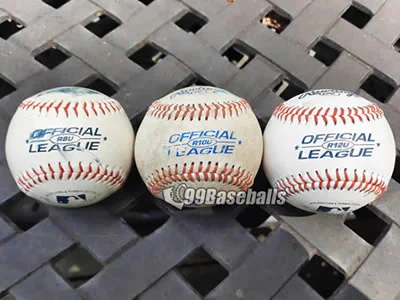
Scouting for the right pill for your young gun isn’t as simple as snagging any old ball from the bucket so in this post, we will be eyeballing the Rawlings R8U, R10U, and R12U balls.
Quick Table
Rawlings 8u baseballs, rawlings 10u baseballs, rawlings 12u baseballs.
Stepping into the batter’s box for the junior league heroes, Rawlings swings big with a duo aimed square at the tykes aged 8 and under.
Enter stage left, the Rawlings R8U, alongside its squadmate, the Rawlings OLB3. These two rookies sport a synthetic hide that, between you and me, might give off a slick sheen or echo that fresh-out-the-box action figure feel.
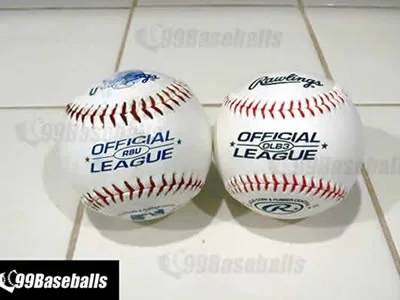
Rawlings R8U and OLB3 baseballs look and feel identical so what is the deal with different names?
It has to do with marketing hype and tolerance specs. Both are intended for youth recreational baseball but OLB3 supposedly has tighter specifications so the weight and size variance is smaller when compared to R8U baseballs. However, I was not able to detect any perceptible differences between these rec baseballs.
One thing to note is that given our little leaguers are working with mitts that haven’t quite hit their growth spurt, Rawlings played smart by trimming just a touch off the standard circumference for both baseballs. Clocking in around 8.75 inches all around, the R8U and OLB3 make it a whole lot simpler for those rising stars to get a good grip and swing for the fences.
In my experience as a coach, R8U and OLB3 baseballs are mostly used in batting cage BP and light fielding drills. And here’s the scoop straight from the horse’s mouth: Rawlings pitches these balls for the practice mound and the casual throw-around. They’re not the ones you’d want to bring to the showdown.
Curious about the official game balls that take the field for the 8U, 10U, and 12U squads? Swing by our guide on Different Types of Baseballs for Different Ages post for the full scouting report.
Rawlings R8U baseball s
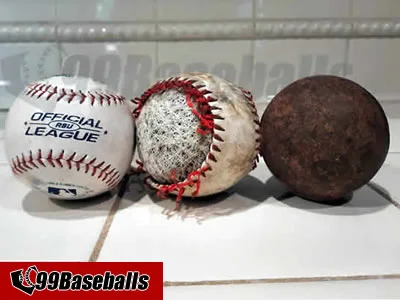
The Rawlings R8U baseball is crafted from a trio of components. The outer cover is synthetic – a heads-up, if you’re scouring for details and can’t find whether it’s leather or synthetic, you’re pretty safe to bet on synthetic. Stitching comes into play as the middleman, binding the shell to the heart of the baseball. At its core , you’ll find a blend of crushed cork and rubber, bonded together to form a solid base, wrapped around with a thin-layer of poly finishing winding.

Tipping the scales, a Rawlings R8U averages out at a solid 4.9 ounces, with the core alone accounting for 4.4 ounces of that weight. This means the heart of the R8U isn’t your standard fare; it skips the usual rubber center for a heftier, cork-dominated nucleus.
Rawlings OLB3 baseball s
The OLB3’s in the ballpark, edging up to that golden 9-inch standard and tipping the scales just a hair over, clocking in at around 5 oz. Eyeing the OLB3, it’s sporting a synthetic cover too. But here’s where it veers off from the R8U:
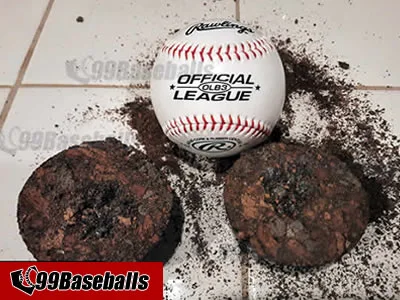
Its synthetic shell’s built a bit tougher, pushing up those seams a notch higher. Peek into its guts, and it’s a rubber-heavy scene. The core’s loaded with bigger rubber chunks, making for a heftier, possibly stickier interior (could be a beefier adhesive at play?).
Now, for the twist—despite its rugged getup, the OLB3’s exterior doesn’t quite hold up as stoutly as the R8U’s in the durability department.
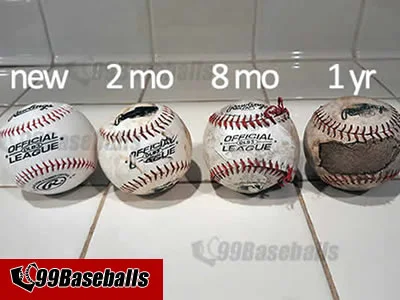
The Rawlings R8U and OLB3 make a decent starting point for players still getting a feel for the game, especially those with smaller hands. That said, I’ve got my reservations about synthetic covers. If you’re looking in another direction, you might want to give the Diamond D-OB baseballs a shot. They match the Rawlings models in terms of performance and safety but stand out with a genuine leather cover, offering a different touch for those who prefer the classic feel.
[Return to top]
In my years coaching and scrutinizing equipment for the young sluggers, Rawlings has pitched two models aimed at the 10-and-under league: the Rawlings R10U and the Rawlings CROLB. Let’s cut straight to the chase—there’s no real difference between these two.
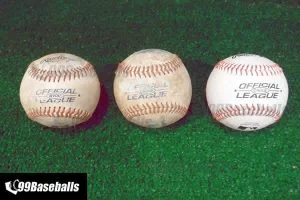
Each is sheathed in what appears to be split leather, a lesser grade of leather that’s been treated and embossed to mimic the higher-quality stuff. They’re both stitched together with a thin poly thread over a core that’s a mix of rubber and cork, strikingly similar to what you’d find in the R8U balls.

From my standpoint, both the R10U and CROLB are adequate for the majority of players aged 10 and under. However, be warned: these balls might not hold their shape if they’re sent flying by a heavy bat, something that’s not uncommon when coaches are lobbing long balls in practice.

So here’s the lowdown:
Neither the Rawlings R10U nor the CROLB makes the cut as official game balls in my book. Sure, they’re cloaked in leather, but there’s a glossy finish that, frankly, feels a bit too akin to the synthetic vibe of the R8U or OLB3 balls.
For the 9-year-olds stepping up to the plate, both balls will do the trick for practice sessions. But for the 10-year-olds, especially those playing at a sharper competitive edge, I’d advise passing on these and opting for the Diamond DOL-1s . These balls have a construction and durability more suited to the demands of players gearing up for the next level.
Stepping up to the plate for the 12U squads, there’s a noticeable shift in the makeup of their baseballs compared to what the younger groups use. For starters, most brands, including Rawlings, opt for a wound yarn construction for this age bracket. This is a game changer—the core is notably smaller than what you find in 10U baseballs, packed with a denser assembly of rubber to add some extra hop to the ball’s bounce.
Breaking it down, we’re talking about a four-part assembly line:
- A leather exterior
- A snug layer of fine thread
- The wound yarn
- A core of cork and rubber

Rawlings throws a couple of options into the ring for the 12-and-under crowd with the Rawlings R12U and the Rawlings ROLB2. Now, if you’re getting a sense of déjà vu comparing these to the R10U and CROLB, you’re not off base. The R12U and ROLB2 are practically twins in both look and guts:
- Each boasts a core that’s 6.25 inches in circumference, tipping the scales at 2.2 oz.
- The heart of the ball is a 50/50 split between rubber and cork, tightly packed for maximum performance.

Yet, it’s a consensus in the coaching circles that these balls are more suited for practice drills.
But let’s drill down on how these stack up against bona fide game balls. Drawing a bead on the 12U tournament scene, teams often swing for either the Rawlings RCAL1 or the MacGregor 74CAL. Here’s the scouting report: the MacGregor comes with a thicker yarn wrap around a smaller “pill”, resulting in a ball that’s quick off the bat, leaving the Rawlings R12U/ROLB2 trailing in the dust.

Next time you’re sizing up those youth baseballs, don’t just chalk it up to the same old ball game. Remember, this isn’t solely about the specs. It’s about tailoring the game to the young sluggers stepping up to the plate, giving them a genuine shot at knocking it out of the park. That’s the kind of insight that really hits home.
Keep in mind, most leagues won’t hand over a bucket of practice balls to managers and coaches. I get it—the struggle to weigh your needs against your budget when stocking up on baseballs is real .
If you’ve found this rundown useful, how about showing some love? Sign up for my newsletter and keep the line drives coming.
Sunday 4th of February 2024
I am trying to figure out what the best baseball to buy my 11 year old is. He picked a bucket out online but I noticed it said 8u he us trying to practice hard so he can become even better and I want him to have the proper equipment! Should we be buying 12u!
8U baseballs have the same dimensions and weight as 12U baseballs.
However, the wool windings in 8U baseballs are much thicker than those in 12U baseballs, designed to absorb the energy from the bat. When hit, 8U baseballs produce a "thud" sound, providing slightly more reaction time for younger players. Additionally, in the unfortunate event of a player being hit by a ball, 8U baseballs will most likely reduce the injury severity.
If Nathan is brand new to baseball, it's perfectly fine to practice with 8u baseballs. Otherwise, I would recommend getting some 12U baseballs. Just ensure his bat grip is in good condition, as these harder baseballs will sting more (if he hits the ball off the sweet spot on his bat).
Hope this helps!
Charley McDaniel
Thursday 22nd of June 2023
Nice article about baseballs learnt a lot.
Baseball Dad
Friday 23rd of June 2023
Hi Charley,
Thank you for your kind words!
Kathy Cameron
Tuesday 14th of March 2023
We have vintage baseballs that were damaged. Can they be restored? Do you. Offer such a service? They were damaged by humidity.
Wednesday 15th of March 2023
Sorry to hear about your vintage baseballs... Unfortunately I do not offer a restoration service :(
- 1800-2121-225
- [email protected]

- Moscow Metro Tour

Activity Details
- moscow tour packages – russian fairy tale tour 6 night / 7 days, activity overview.
- Description
- The Moscow Metro is among the biggest and thickest metro networks in the world.
- This makes it easier for people to travel quickly in Moscow.
- The Moscow Metro is made up of 12 lines and 200 stations, and it is around 333 kilometers long.
Activity Important
- Important to know
- Certified English speaking local guide.
- Hotel/port pickup and drop.
- Tips and personal expenses.
- Instant package confirmation at the time of booking.
- This package does not qualify for any refund policy.
- You will need to present either a paper or an electronic voucher for this activity.
Other activities in Russia

Senate Square Tour

Red Square Tour

Moscow Tour
For tour package: moscow metro tour.

Newsletter Sign Up Sign up and Get Our Amazing Offers
Members can access discounts and special features
Elektrostal, visit elektrostal, check elektrostal hotel availability, popular places to visit.
- Electrostal History and Art Museum
You can spend time exploring the galleries in Electrostal History and Art Museum in Elektrostal. Take in the museums while you're in the area.
- Cities near Elektrostal

- Places of interest
- Yuri Gagarin Cosmonaut Training Center
- Peter the Great Military Academy
- Central Museum of the Air Forces at Monino
- History of Russian Scarfs and Shawls Museum
- Balashikha Arena
- Balashikha Museum of History and Local Lore
- Bykovo Manor
- Pekhorka Park
- Ramenskii History and Art Museum
- Malenky Puppet Theater
- Military Technical Museum
- Church of Our Lady of Kazan
- Drama Theatre BOOM
- Fryazino Centre for Culture and Leisure
- Likino Dulevo Museum of Local Lore
- Noginsk Museum and Exhibition Center
- Shirokov House
- Pavlovsky Posad Museum of Art and History
- Saturn Stadium
- Borisoglebsky Sports Palace
- Zheleznodorozhny Museum of Local Lore
- Stella Municipal Drama Theater
- Fairy Tale Children's Model Puppet Theater
- Fifth House Gallery
- Church of Vladimir
- Malakhovka Museum of History and Culture
- Art Gallery of The City District
- Orekhovo Zuevsky City Exhibition Hall
Expedia Rewards is now One Key™
Elektrostal, visit elektrostal, check elektrostal hotel availability, popular places to visit.
- Electrostal History and Art Museum
You can spend time exploring the galleries in Electrostal History and Art Museum in Elektrostal. Take in the museums while you're in the area.
- Cities near Elektrostal

- Places of interest
- Yuri Gagarin Cosmonaut Training Center
- Peter the Great Military Academy
- Central Museum of the Air Forces at Monino
- History of Russian Scarfs and Shawls Museum
- Balashikha Arena
- Balashikha Museum of History and Local Lore
- Bykovo Manor
- Pekhorka Park
- Ramenskii History and Art Museum
- Malenky Puppet Theater
- Drama Theatre BOOM
- Likino Dulevo Museum of Local Lore
- Noginsk Museum and Exhibition Center
- Pavlovsky Posad Museum of Art and History
- Saturn Stadium
- Fairy Tale Children's Model Puppet Theater
- Fifth House Gallery
- Church of Vladimir
- Malakhovka Museum of History and Culture
- Orekhovo Zuevsky City Exhibition Hall

IMAGES
VIDEO
COMMENTS
USSSA Age Chart - 2024 Spring Season. To determine league age under USSSA Baseball, you follow a similar process as with other leagues but with a specific age cut-off date. USSSA uses a May 1 cut-off date. This means that a player's age on April 30 of the current season determines their league age for that season.
Local Travel Teams: For beginners starting their journey through travel baseball. The games they play are mostly local or within a close driving distance. Practices only happen a few times a week, and games during the weekend. 2. Regional Travel Teams: For players with more experience and higher skill levels.
1 TABLE OF CONTENTS Item Page Foreword 1 Rule 1.00 - Name & Objective 1 Rule 2.00 - Membership, Participation & Classifications of Play 1 Rule 3.00 - Individual Player & Team Eligibility 2 Rule 4.00 - Qualifying Tournaments 4 Rule 5.00 - State Championships 4 Rule 6.00 - World Series 5 Rule 7.00 -Rules of Play 5 Rule 7.01 - Playing Field & Equipment 5
Player Competition Age: {{ageInfo.playersAge}} Athlete's Current Grade: {{ageInfo.grade}}
Championship Games 9U-12U, six innings or 1:40 time limit. Championship Games 13U and up, 7 innings or 1:40 time limit. Umpires keep official time. 8U is six innings or 1:10 time limit with Championship Games six innings or 1:20 time limit. SATURDAY ONLY tournaments, Facility conditions or Number of Teams game times may be reduce to accomodate ...
The specific answer varies, but the typical range of cost for participating in travel baseball is between $500 and $2,500 per year. That said, you can end up spending a lot more than that. Back in 2011, CBS News reported that one Georgia family paid $4,000 per year for their 9-year-old son's travel team.
Your player's league age is determined by the USSSA Baseball Age Charts. League Age determines the division in which a player will participate in. ... 8U: May 1, 2013: April 30, 2014: 9U: May 1, 2012: April 30, 2013: 10U: May 1, 2011: April 30, 2012: 11U: ... sponsors travel money, and berths that would have been or have been awarded. 3.1.B ...
2021 9U Gray. Teams. WPPA offers multiple travel teams (Black, Red, and Gray) across all age groups. The 8U to 12U ages are part-time "All-Star" programs where travel players are required to participate in the WPPA house league, in addition to the "All-Star" program. The 13U and 14U programs, however, will be "Full-time" programs ...
This is our ever-growing list of 8u travel baseball teams looking for players and we've spent hours compiling them into an easy to use resource. Our list of 8u travel baseball players is organized by city, state & zip code and it the list of travel baseball teams gets bigger every day! Using our tools you can find travel or club baseball teams ...
You may only select one age group to register for each season (you cannot register for 9u, not get offered a spot and register for 8u) 8U: May 1, 2015 - August 31, 2016. 9U: May 1, 2014 - August 31, 2015. 10U: May 1, 2013 - August 31, 2014. 11U: May 1, 2012 - August 31, 2013. The 7U team will be formed in the Spring season while all other ages ...
A player's age on April 30th determines his or her eligibility for the HPBA Baseball travel teams and September 1st for HPBA Softball travel teams. Baseball Travel Programs. ... Birth Certificate Requirements: Yes; Due by Oct 1: Yes, 8U-9U due by February 1; 10U-13U by November 1: Cost (per player) $2,105 - $2,620**
Any player that turns 4 years old in the months of May, June, July, and August born in 2020 is eligible to participate in the Cal Ripken T-Ball Division. 13-16 - Any player born prior to May 1, 2011 and on or after May 1, 2007 will be eligible for Babe Ruth 13-16 League competition. 16-18 - Any player born on or after January 1, 2005 will ...
Age Calculator. Enter the information below to calcaulate age group. Birth Date:
Also, any player turning 16 prior to August 1 will not be eligible. Players who are 14U eligible are eligible for this division regardless of grade. * 15U Division Players who turn 16 prior to May 1 of the current season are not eligible unless they are a freshman in High School. Also, any player turning 17 prior to August 1 will not be eligible.
Organization Name City Postal Code Team Logo Age Group ; Deep South Choccolocco Championship (Major) Anniston : 36203 : 8u, 9u, 10u, 11u, 12u, 13u, 14u, 15u, 16u
Age Determination - Age cutoff date is May 1st. See Below Examples: All teams will move up in age on August 1st of each year. 8u-Cannot turn 9 prior to May 1, 2024. 9u-Cannot turn 10 prior to May 1, 2024. 10u-Cannot turn 11 prior to May 1, 2024. 11u-Cannot turn 12 prior to May 1, 2024. 12u-Cannot turn 13 prior to May 1, 2024.
The 8u and 9u tryouts will be conducted by the coaches identified for those age groups as well as the Baseball Committee members, using experienced, knowledgeable baseball evaluators. ... Travel Program Team Requirements: Orchard Park travel baseball team expectations will differ between each level and coach. The 8u-12u travel teams will ...
On the flip side, when we venture into the competitive realm—think travel and tournament baseball—teams are built around a precise age bracket, like 8U, 9U, 10U, and so on. But, here's the curveball: there's a bit of wiggle room for kiddos born in a certain month. Let's play out a scenario: Today's March 1, 2024.
What age groups does Express have? Express: 7U, 8U, 9U, 10U, 11U & 12U. Fishers High School and HSE High School have their own travel teams at 13U & 14U. The Fishers High School (13U and 14U teams) remain under Mudsock Youth Baseball. What group does my child fit into? Express follows the USSSA Rules for age requirements.
This makes it easier for people to travel quickly in Moscow. The Moscow Metro is made up of 12 lines and 200 stations, and it is around 333 kilometers long. Most of the stations are open from 5:30 a.m. to 1:00 a.m. The metro entrances are marked with green signs on the doors, and the metro exits are marked with red signs. ...
Drive • 1h 3m. Drive from Elektrostal to Moscow 58.6 km. RUB 450 - RUB 700. Quickest way to get there Cheapest option Distance between.
Travel guide resource for your visit to Elektrostal. Discover the best of Elektrostal so you can plan your trip right. Vacation Packages. Stays. Cars. Flights. Support. All travel. Vacation Packages Stays Cars Flights Cruises Support Things to do. My Account. Members can access discounts and special features.
Travel Guide. Check-in. Check-out. Guests. Search. Explore map. Visit Elektrostal. Things to do. Check Elektrostal hotel availability. Check prices in Elektrostal for tonight, Apr 20 - Apr 21. Tonight. Apr 20 - Apr 21. Check prices in Elektrostal for tomorrow night, Apr 21 - Apr 22. Tomorrow night.